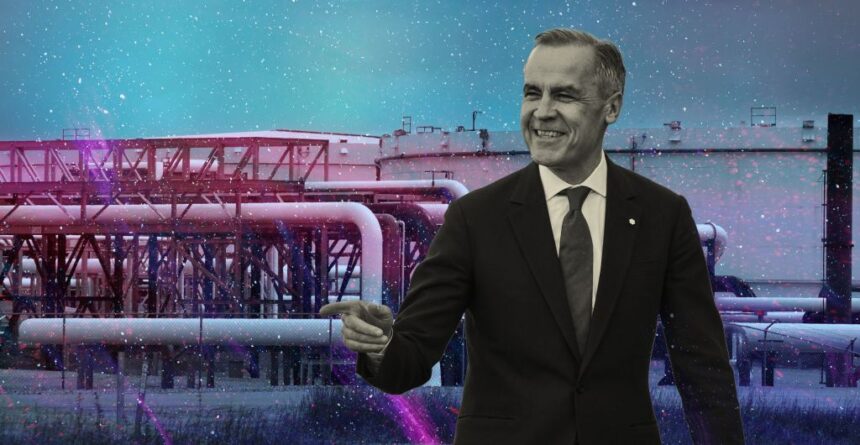We’ve all pondered the sound of a tree falling in the forest. Many have also sought the answer to life, the universe and everything. But have enough of us considered the philosophical quandary of debating nothing at all? That’s the existential question most relevant in Canadian politics at the moment, where a great nation-building push by the federal government has so far only succeeded in building confusion — and, here in the restive province of Alberta, got many up in arms over the perceived lack of support for a project that doesn’t exist. Prime Minister Mark Carney was elected on the promise of pushing back against aggression from the U.S. and its trade war. A big part of his response was to pass legislation that would allow the government to “fast-track” grand projects his cabinet deemed to be in the “national interest.” Since then, his government has made two big announcements touting its pet infrastructure projects — neither of which actually designated any projects in the national interest to be put on a fast track. Instead, the government only referred 11 projects — including an expansion of the Port of Montreal and wind-powered energy generation in the Atlantic — to the newly created Major Projects Office for consideration as nationally interesting “major projects” worth fast-tracking. Which means no real projects have actually moved forward, despite the rhetoric around the announcements. That lack of clarity, and of tangible action, only adds to the sense of disorientation over intense reaction in Alberta when a new pipeline to the West Coast wasn’t part of the latest announcement. Emotions were pretty strong considering there isn’t an actual pipeline project being discussed — there’s no route, no budget, no company that currently wants to build it. The most tangible thing about it so far has been vocal opposition from B.C. and the Indigenous communities this imaginary pipeline would theoretically pass through. It is a debate about something that doesn’t exist being snubbed for inclusion on a list that does nothing — unless you count politicking. And while Alberta is being the most dramatic about it all, it’s a situation playing out all over the country. A primer on how a non-existent pipeline could get designated for fast-tracking … we think Before getting into the imaginary pipeline debacle between Alberta, B.C., First Nations and the feds, let’s set the stage. Carney’s first act after his April election was to introduce and pass Bill C-5, the Build Canada Act, the legislation that would allow the government to fast-track projects. Selected projects could essentially be pre-approved for meeting a raft of regulations (although, confusingly, not be exempt from them). It immediately set off alarm bells about the rigor of any required environmental assessments and raised serious concerns about Indigenous participation, consultation and consent. Prime Minister Mark Carney’s first order of business once elected was to introduce legislation he said would speed up nation-building projects. Since then, his government has made two major announcements of projects, none of which have been designated for fast-tracking. Now, he’s facing a precarious balancing act on development, climate, Indigenous rights and provincial interests. Photo: Kamara Morozuk / The Narwhal Since then, the government has listed 11 projects and seven “transformative strategies” in widely covered announcements that only serve to muddy the debate. The point of this all is unclear, since those projects and strategies were already underway, some in advanced stages, and none of them were declared in the national interest and set for fast-tracking. Yet. These 11 projects are a short list. There is also a longer list, which is secret, according to the Privy Council Office, of projects in various stages of preparation for presentation to the Major Projects Office.Finally, there’s the list of projects set for fast-tracking, which is empty. So far. Those projects would have to be designated in the national interest, then move through a legislative process, consultations with impacted Indigenous people, the province where the project will be built if it’s under provincial jurisdiction, a national security review and more. It’s not necessarily a short road to travel. Alberta’s pipe dreams Alberta’s United Conservative Party government, facing and facilitating a burgeoning separatist movement at home, has been aggressively pushing to double oil and gas production while pushing back against emissions regulations. When Carney announced his major projects plan, the party decided the lack of a company interested in building a new pipeline shouldn’t be an impediment. Nor, apparently, should the basic questions that remain unanswered about the need for a new pipeline and the economics that would support it. Capacity wise, Enbridge has approved expansion of existing pipelines and TransMountain is proposing changes that will allow it to carry more bitumen to the West Coast. Alberta Premier Danielle Smith, however, says it’s not enough. Profit wise, both of those expansions are forecast to exceed production increases and demand. In addition, the International Energy Agency is forecasting significant surpluses in supply versus demand on the global market, possibly reaching a glut of four million barrels per day in 2026 — something the agency calls “untenable.” Together, the elements standing in the way of a hypothetical pipeline are significant, but that might not really matter. It didn’t matter to Smith on Oct. 1 when, alongside several cabinet ministers, she announced her province would be the proponent for a pipeline, committing $14 million towards early planning work to get “a credible proposal” in front of the federal government. What Alberta wants from the federal government is a memorandum of understanding that could pave the way for a hypothetical project, but is also aimed at getting rid of what Smith calls the Nine Bad Laws — including the ban on large oil tankers on the northwest coast, an idea Coastal First Nations and the B.C. government opposed adamantly in a declaration signed earlier this month. Alberta Premier Danielle Smith has been pushing hard to grow the province’s oil and gas sector. Her government’s latest move involves investing tax dollars in the early stage of a pipeline project that doesn’t have a private sector partner, funding or a route, hoping it will be designated a national-interest project. Photo: Drew Anderson / The Narwhal Smith was hoping for that to happen within a month of her announcement. But, again, no route, proposal or company willing to build has been made public. Alberta is essentially spending millions to make an outline of a project that it hopes someone will build if Ottawa says it’s a good idea, despite fierce opposition from the one place it will have to cross. Coastal First Nations and B.C. really, really, really oppose a new pipeline As soon as Carney started his push for more nation-building projects, he met opposition. There’s serious concern about the potential for fossil fuel-based energy projects being fast-tracked in the era of climate change — which brings its own Canada-wide challenges, such as the ballooning costs and labour pressures of responding to floods, wildfires and other global-warming-fuelled natural disasters. From First Nations whose territory lies between the Alberta oilsands and the West Coast to nations in Ontario, Alberta and Manitoba, Indigenous communities are extremely unhappy they weren’t consulted on the Build Canada Act, which could directly impact their constitutional rights to consultation and consent. In the particular case of a pipeline, it’s difficult to see a physical or political path forward. Along with nations along the (imaginary) route, the idea of lifting the tanker ban has appalled Coastal First Nations and the B.C. government. And yet, on Wednesday, The Globe and Mail reported Alberta and the federal government were close to a deal on the pipeline project that doesn’t exist, with sources telling the paper it would, indeed, require lifting the oil tanker moratorium on at least a section of the coast. “We are incredibly alarmed to read media reports about alleged negotiations between the federal government and the province of Alberta” about a new pipeline, Coastal First Nations said in a press release on Nov. 19. It added that the passing of the tanker ban in 2019 was the result of over “50 years of advocacy.” National political interest project According to The Globe, the feds’ negotiations with Alberta include winning the province’s buy-in for the industrial carbon price, which Alberta has been trying to weaken. There will also, inevitably, be a windfall for carbon capture and storage projects. It’s a classic political give and take. Carney could buy peace with a province that has been anything but peaceful for the past six years,, currently governed by a party that has actively pushed for more sovereignty while making it easier for separatists to push their agenda. Smith herself has put the future of confederation on the table if the federal government doesn’t acquiesce to her demands. But ever since Carney’s election, the anti-Ottawa rhetoric from her government has been tamped down, even before talk of the hypothetical pipeline. It’s a sign that Carney’s strategy of compromise might be working — that Smith is either getting what she wants or thinks she is. A reported deal being hashed out between Alberta and Ottawa on a new, hypothetical, bitumen pipeline would likely include Alberta supporting industrial carbon pricing if the feds pledge to funnel the proceeds back into a proposed carbon capture and storage project. Photo: Amber Bracken / The Narwhal If reports are accurate, she might be getting rid of at least some of the environmental regulations, including the tanker ban and an emissions cap on oil and gas, her government bristles at. She can claim victory for pushing a pipeline project forward, even if no pipeline is ever built. Even without any actual infrastructure, agreements to agree on … something? … are not an insignificant political framework for two traditionally combative sides to erect. Unfortunately for them, they aren’t the only two pieces on the board and Carney’s balancing act is precipitous. The prime minister has made big promises to industry and to Canadians, while fighting a trade war and a restive collection of provinces with often vastly different ideas on the best economic and social paths forward. B.C. is already unhappy. So are Indigenous communities in national-interest-major-projects-fast-tracking regions across Canada. It’s also unclear when, and if, Carney will start designating projects for fast-tracking through his new Major Projects Office, and how much more backlash that could stoke. If these projects never see the light of day, despite the federal government’s efforts, Carney also risks disappointing those who want to see them built. The anger that could engender is significant. Tipping the national balance could be a high price to pay for a reprieve with Alberta, and one that isn’t guaranteed, but pipelines don’t come cheap either. Maybe. If there ever is one. With a budget. Or someone to build it. It’s remarkable how much nothing can do. Recent Posts Fast track to where? Carney’s major projects list stirs up emotions, and not much else Nov. 21, 2025 9 min. read Alberta is pushing for a pipeline that doesn’t exist to be included on a list… Canada says anti-greenwashing law prevents industry from ‘speaking up’ Nov. 21, 2025 7 min. read Prime Minister Mark Carney is moving to nix some rules around how fossil fuel companies… RSVP: Unpacking Carney’s major projects push Join The Narwhal for a free Zoom event on Dec. 2 to unpack the process,…
Fast track to where? Carneys major projects list stirs up emotions, and not much else












